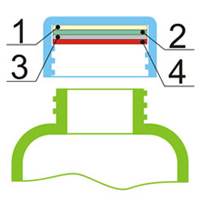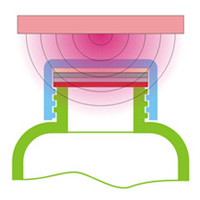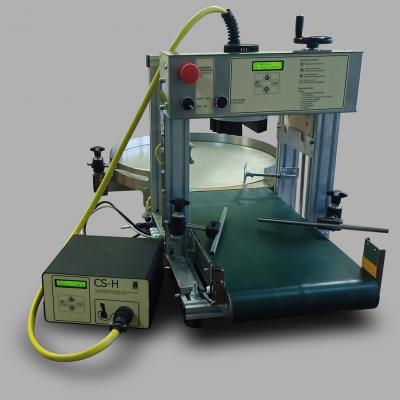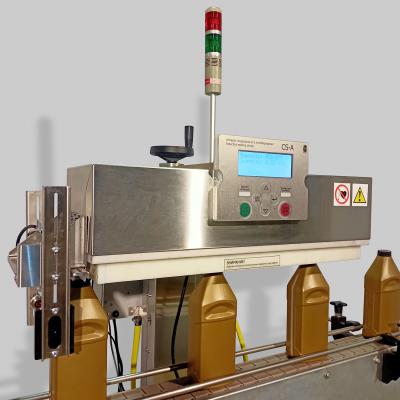The induction sealing process connects a foil insert to the neck of a container. After the container has been filled and capped with a special liner, it passes underneath the induction sealing machine. The non-contact heating welds the liner to the lip of the container creating a hermetic seal.
When properly applied, induction lined caps provide a hermetic, leak proof, and tamper evident seal. Using an induction sealing system is ideal for extending product shelf life, preserving freshness, preventing leaks and enhancing your product's value. This technology most commonly used in the pharmaceutical, chemical and food industry.
About the technology
 Container goes to the sealing process already filled with product and with an aluminum foil liner already inserted into the cap. Typical induction liners are multi-layered.
Container goes to the sealing process already filled with product and with an aluminum foil liner already inserted into the cap. Typical induction liners are multi-layered.
For example we will use the most common type of liners with layers connected by wax:
1 – base(cardboard)
2 – temporary adhesive layer (wax)
3 – aluminum foil
4 – heat seal lacquer

As the container passes under the induction coil (sealing head) the conductive aluminum foil liner begins to heat due to eddy currents. The heat melts the wax and releases the foil from the cap. The heat seal lacquer layer also heats and flows onto the lip of the container.
 When cooled, the foil attaches to the container giving us a hermetically sealed product. Neither the container nor its contents are harmed. Generated heat does not negatively affect the products.
When cooled, the foil attaches to the container giving us a hermetically sealed product. Neither the container nor its contents are harmed. Generated heat does not negatively affect the products.
Equipment
Induction sealers can be divided into two groups: semi-automatic and automatic. Semi-automatic equipment requires an operator who will control sealing process and position of container. Automatic equipment is installed above the conveyor on which containers for sealing are moving. In this case operator's constant attention is not required.
 Universal induction sealing machine CS-H
Universal induction sealing machine CS-H  Automatic induction sealing machine CS-A
Automatic induction sealing machine CS-A
Equipment composition
Induction sealing machine consists of an induction head and power unit (generator). Induction head is a coil wrapped with special power cable in the magnetic system made from magnetically soft material. Generator is the power transistor transformer that contains a control system with close circuit(loop) and has a display for parameters setting. The display can also be made as a single remote that can be placed in an easily accessible place. Machines can be equipped with floor and table tripods, and devices for diagnostic and rejection of the package.
Safety measures while working with induction sealer
It must be remembered that an alternating magnetic field warms up any conductor located in the working range of the induction head. So there is a need to avoid entering of the metal objects and electrical appliances in the scope of the inductor. This refers to the metal rings and other jewellery, elements of conveyors, tools, electronic devices (cell phones, computers, etc.), and pacemakers.
How to eliminate defects?
In this case defects are: absence of aluminum foil liner, nonhermetic seal or damaged foil.
Modern induction sealing machines are provided with tools for diagnostic of availability of foil under the lid. This allows you to reject the containers without the foil liner. In semi-automatic mode, the operator carries out separation; in automatic mode it requires automatic rejection devices.
Nonhermetic sealing may be associated with irregular plane of the neck, mismatch(misfit, incompatibility) between heat-sealing layer of liner and material of the container, selection of the wrong sealing mode, inaccurate centering of the inductor or the equipment defect.
Burning of the foil may be caused by selection of the wrong sealing mode, inaccurate centering of the inductor or the equipment defect.
While sealing neck of the container must be parallel to the inductor and centered. Parameters of the sealer should be selected to match the diameter of the foil. Quality of the sealing changes due to the distance between liner and induction coil and to the foil heating temperature.
For the stable quality of the sealing process there is a need in equipment with closed regulation circuits. In this case dosage of power does not depend on various factors such as temperature, humidity, voltage, aging of the elements(components, parts, details),etc. Such equipment may be more expensive, but it provides high and stable quality throughout the whole service life of the inductor sealer. Also, there is no need for operator to control(check) voltage or quality of sealing in this case.
To ensure secure sealing of the product at the outlet it is possible to use special automatic or semi-automatic equipment for impermeability control.
Sealing parameters setting
For semi-automatic equipment these settings are available to customize: power level, exposure time, gap between covers and induction head.
For automatic equipment these settings are available to customize: power level, conveyor speed, gap between covers and induction head.
Setting of the sealer carried out experimentally. For the semi-automatic devices: sealing time is selected and power is adjusted from 20% to the moment of proper sealing by increasing power level by 5-10%. For the automatic equipment: at first, conveyor speed must be set and then the 4mm gap between covers and inductor (the gap should be constant over the entire length of the inductor). The containers must be centered relative to inductor. At last, power level is selected for optimal sealing.
